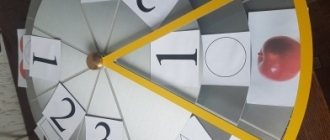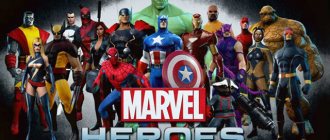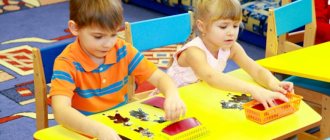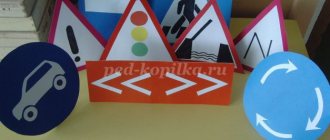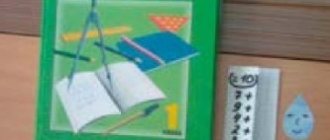Preparatory group. Senior preschool age. Children 6-7 years old
Summary of GCD for FEMP in the preparatory group “Opening a furniture store” Summary of GCD for FEMP in the preparatory group “Opening of a furniture store”
Author: Natalya Afanasyevna Koryakina, teacher at MKDOU No. 107, Kirov.
Topic: “Opening a furniture store”
Integration of areas:
“Cognitive development”
,
“Social and communicative development”
,…
Abstract of educational activities on FEMP for children from 6 to 7 years old “Journey to the country of Mathematics” Synopsis of direct educational activities with preschool children (6-7 years old)
Educational area:
“Cognitive development”
Topic of GCD:
“Journey to the country of Mathematics ” (consolidation of the
material ) Goal: consolidation, application of what children have previously learned ...
LESSON ON FORMING ELEMENTARY MATHEMATICAL CONCEPTS IN A PREPARATORY GROUP
The material is published in the Printed collection of practice-oriented materials “Preschool and primary education - modern methods and technologies of teaching and upbringing - JUNE-2021”
Malaya Tatyana Viktorovna
teacher
FGKDOU "Kindergarten No. 158" MORF
Khabarovsk-47
LESSON ON FORMING ELEMENTARY MATHEMATICAL CONCEPTS IN A PREPARATORY GROUP
Program content:
- Teach children to do arithmetic addition problems.
- Strengthen the ability to see geometric shapes in surrounding objects.
- Develop attention, memory, logical thinking.
Advertising message
Demonstration material: vase, 4 flags. 3 cubes, squares of two colors, 3 triangles of the same color, logical blocks, mosaic Geometric shapes.
Handouts: Triangles of two colors, counting materials, cards with images of figures.
Guidelines
Part I. Game exercise “Getting ready for school.”
The teacher brings an envelope with the teacher’s assignments to the group and invites the children to complete them.
- The teacher calls two children to the board. Reads the task and asks one child to place 2 cubes on the table at a short distance from each other, and the other child to place 1 more cube on top.
Then he asks: “What did the children build? How many dice did Vlad bet? How many dice did Ilya place? Let’s make up a problem about what the boys did: “Vlad put two cubes on the table, and Ilya put another cube on top. How many cubes did the children place? (Children repeat the problem.) In order to answer the question of the problem, you need to solve it.”
The teacher calls two more children to the board. He asks them to use magnets to place on the board as many squares of the same color as Vlad placed cubes, and as many squares of a different color as Ilya placed. Children count the squares and answer the question of the problem: “Vlad and Ilya put three cubes together.”
- The teacher reads the following task and asks one child to place 3 flags in a vase, and the other to place 1 flag. Clarifies: “How many flags did Ksyusha put in the vase? How many flags did Zoya check?”
Children talk about the actions of Ksyusha and Zoya and name the number of checkboxes they checked.
The teacher explains the task: “Ksyusha put three flags in the vase, and Zoya put one flag. This is the condition of the problem. The problem must also contain a question: what needs to be learned in the problem. In our task we need to find out how many flags the children put in the vase.”
Children repeat the question of the problem and pronounce the problem in full. Then the teacher asks: “What parts does the task consist of? What is a “problem condition”? What is a “problem question”?
Children repeat the entire task. The teacher explains: in order to answer the question of the problem, it must be solved. He invites the children to count as many triangles of the same color as the number of flags Ksyusha put in the vase, and as many squares of a different color as the number of flags Zoya put in the vase. Children count the squares and answer the question of the problem: “Ksyusha and Zoya put four flags in a vase.” The teacher clarifies the structure of the arithmetic problem.
Physical education minute.
The teacher reads a poem, and the children perform the appropriate movements:
We raise our hands up,
And then we lower them.
Now let's separate them
And we’ll quickly press you to us.
And then faster, faster
Clap, stomp more joyfully.
II . Game "Find the odd one out"
The child is shown a set of any 3 randomly selected elements of a set of counting materials, logical blocks, or geometric mosaics. The child’s task is to find which element is superfluous and justify his answer.
The teacher should understand that there will not be a clear answer and the most important thing in this exercise is the child’s explanation based on the property that he saw and considers important. The teacher can point out to him that his answer is not the only one and this is a task with a secret - then the child will find another reason for highlighting the odd one out in the group.
Modification of the game: when children master the work of identifying features, you can give them a wider range of objects: from 4, 5 objects.
III . Game exercise “Finish the row.”
The teacher, together with the children, examines the table and clarifies: “What figures are in the first (second, third) row? Are they the same color? What shape is missing and what color? Draw this figure."
After completing the task, the teacher shows a sample, the children compare their drawings with it and explain the correctness of the answer.
IV . Understanding.
The teacher restores in the children’s memory what they did in class, creating a situation of success.
- What did we do today?
– What parts do tasks consist of?
– Which task did you like best?
The teacher praises the children and says that they were great today and completed all the tasks.
Literature:
- Zhukov "Notes of classes with children in a preparatory school group."
- Nikitin B.N. "Educational games for children".
- Pomoraeva I.A., Pozina V.A. Formation of elementary mathematical concepts. School preparatory group (6–7 years old).
- Program for mathematical development of children 5-7 years old “Fascinating mathematics” / N.A. Nadezhdina, T.N. Ermakova.
- Uzorova O., Nefedova E. “1000 exercises to prepare for school.”
Methodology for conducting ECD on FEMP in the preparatory group
Lyudmila Ryabova
Methodology for conducting ECD on FEMP in the preparatory group
Content:
1. Methodology for conducting GCD in the preparatory group....3
2. Analysis of software tasks….5
3. Summary of GCD…. 7
4. Recommended didactic games for the preparatory group.... 10
5. References...12
Methodology for conducting GCD in the preparatory group
The methodology for conducting ECD includes the following components: implementation of all types of children's activities and the use of various forms of organization of children, which depend on the degree of activity of children, interest, independence skills, level of communication, age and individual characteristics of children, type of activity, complexity of the material.
In the methodology of mathematical development of preschoolers, much attention is paid to the problem of teaching them computational activities. However, only as a result of targeted, systematic work do they develop sufficiently strong and conscious knowledge and skills in computational activities, and this is an important prerequisite for mastering mathematics at school.
Children in the preparatory group are introduced to arithmetic operations - addition and subtraction. This work is being carried out in stages . In several lessons, the relationship between the operations of addition and subtraction should be revealed. Familiarization is carried out on the basis of examining drawings, from which problems on addition and subtraction can be made. After using a certain number of exercises, children should be able to draw a conclusion: if we subtract the second term from the sum, we get the first term. Understanding the relationship between addition and subtraction is used later in checking the correctness of the answer .
Training in direct educational activities, regardless of the form of its organization, differs primarily in its programming. The teacher outlines the program content that should be implemented during the GCD.
Classes have a certain structure, which is largely dictated by the content of training and the specifics of the children’s activities. Regardless of these factors, in any lesson there are three main parts, inextricably linked by general content and methodology , namely: the beginning, the course of the lesson (process)
and ending.
The beginning of ECD presupposes the direct organization of children: it is necessary to switch their attention to the upcoming activity, arouse interest in it, create an appropriate emotional mood, and reveal the educational task. Based on the explanation and demonstration of methods of action, the child forms an elementary plan: how he will need to act himself, in what sequence to complete the task, what results to strive for.
Progress (process)
GCD is an independent mental or practical activity of children, consisting in the acquisition of knowledge and skills that are determined by the educational task. At this stage of the lesson, techniques and teaching are individualized in accordance with the level of development, pace of perception, and thinking characteristics of each child. Appeals to all children are necessary only if many have errors in completing a learning task as a result of an unclear explanation from the teacher.
Minimal assistance is provided to those who quickly and easily remember, are attentive, know how to analyze, and compare their actions and results with the instructions of the teacher. In case of difficulty, advice, reminders, and a guiding question are enough for such a child. The teacher gives each student the opportunity to think and try to independently find a way out of a difficult situation.
The teacher must strive to ensure that each child achieves a result that indicates his progress, showing what he has learned.
The end of the ECD is devoted to summing up and assessing the results of children's educational activities. The quality of the result obtained depends on the age and individual characteristics of the children, and on the complexity of the learning task.
Depending on the section of training and the goals of the lesson, the methodology for conducting each part of the lesson may be different. Private methods provide more specific recommendations for conducting each part of the lesson. After the lesson, the teacher analyzes its effectiveness, the children’s mastery of program tasks, reflects on the activity and outlines the prospects for the activity.
Software task analysis
Our kindergarten "Gnome"
works according to the program
“From birth to school”
edited by N. E. Veraksa, T. S. Komarova, M. A. Vasilyeva, (3rd edition, corrected and expanded, Mozaika-Sintez publishing house, Moscow, 2014 - 368 pp.)
Let us analyze the structure of the program, its content and program tasks for the formation of elementary mathematical concepts in preschoolers.
Program structure:
Formation of elementary mathematical representations ( FEMP )
-one of the educational areas
“Cognitive Development”
program.
The main goals and objectives of the FEMP are the formation of primary ideas about the basic properties and relationships of objects in the surrounding world: shape, color, size, quantity, number, part and whole, space and time.
Preparatory group for school.
Improve and develop skills, expand the understanding given to children in the senior group . Tasks are added:
Quantity and counting. Introduce counting within 20 without operations on numbers, introduce numbers in the second ten. Learn to name numbers in forward and reverse order, next, previous, missing numbers.
Introduce the composition of numbers within 10. Learn to decompose a number into two smaller ones and make a larger number from two smaller ones.
Introduce coins.
Learn, on a visual basis, to compose and solve simple arithmetic problems involving addition and subtraction, and use action signs when solving problems.
Magnitude. Learn to count according to a given measure, when a unit of counting is understood as not one, but several objects or part of an object .
Divide an object into 2-8 or more equal parts by bending, using a conventional measure, correctly designate the parts. Develop initial measurement skills. Learn to measure length, height, width.
Learn to measure the volume of liquid and granular substances using a conventional measure.
Give an idea of weight and how to measure it.
Form. Give an idea of a polygon, straight line, segment.
Learn to recognize shapes in space, place them on a plane, organize, classify.
Model geometric shapes, construct shapes based on verbal descriptions and listing their properties, create thematic compositions from shapes according to your own ideas. Analyze the shape of objects as a whole and individual parts using contour patterns, descriptions, and presentation.
Orientation in space. Learn to navigate a limited area, place objects and their images in the indicated direction, and reflect their spatial location in speech.
Introduce the plan, diagram, route, map.
Learn to "read"
the simplest graphic information indicating the spatial relationships of objects and the direction of their movement in space.
Orientation in time. Give elementary ideas about time: its fluidity, periodicity, irreversibility, the sequence of days of the week, months, seasons.
Learn to use the concepts: “first”
,
“then”
,
“before”
,
“after”
,
“at the same time”
.
Develop a “sense of time”
, learn to tell by the clock with an accuracy of one hour.
Feature of the program.
The program comprehensively presents all the main content areas of education, training and development of a child from birth to 7 years. Education is seen as the process of introducing a child to the main components of human culture.
Abstract of GCD ( preparatory group )
Program content:
• Continue to teach yourself how to compose and solve problems involving addition and subtraction within 10.
• Practice your ability to navigate on a sheet of squared paper.
• Learn to “read”
graphic information indicating the spatial relationships of objects and the direction of their movement.
• Develop attention, memory, logical thinking.
Didactic visual material
Demonstration material. Colored pencils, sample maze (see Fig. 66, number line, 2 plot pictures with 8–10 differences.
Handout. Checked notebooks with images of two number lines consisting of 10 cells (see Fig. 62, pencils, pictures of labyrinths (see Fig. 66)
.
Guidelines
Part I. Game exercise “Make the pictures similar”
.
There are 2 pictures on the board. The teacher invites the children to look at them, find the differences between them and complete the drawing of the object so that they become similar.
Part II. Game task “Drawing a task”
.
The children have notebooks in a square with the image of two number lines. The teacher asks: “How many cells are on the number line?”
(Ten cells.)
Children mark with an arc on the number line, first 4 cells, and then another 5 cells (they check the correctness of the task with the model on the board)
. Based on the drawing, a record is made for the future task using numbers and arithmetic signs.
Children read the entry, the called child lays it out on the board. Based on the notes, children create a task. The teacher listens to the problem options. Children, together with the teacher, justify the correctness of their composition, solve and answer the questions of the problem, and explain its solution.
On the second number line, children use arcs to mark 9 cells (above)
and 5 cells
(bottom left)
. Then they compose and solve a subtraction problem in the same way.
Physical education minute
The teacher reads the poem and performs the appropriate movements together with the children.
Point your finger at the hare (Clench your right hand into a fist and straighten your middle and index fingers.)
Book, (Put two open palms next to each other.)
Nut. (Clench your fist.)
index finger
Everything is known best. (Stretch your index finger up, bend and straighten it.)
The exercise is repeated 2-3 times with a change of hands.
Part III. Game exercise “Hide the figures”
.
From the previous task in the notebooks, children count down 4 cells. The teacher gives them a new task: “Draw a square with a side equal to two cells. Step back three squares and draw another similar square. Continue drawing squares until the end of the line."
After completing the task, he asks the children: “Which figure have we already hidden in the square?” (Circle.)
The child on the board, with the help of the teacher, shows how to fit a circle into a square. Children complete the task in their notebooks.
The teacher invites the children to think about what other figure can be hidden in the square. (Triangle.)
Shows how to fit a triangle into a square: the upper side of the square must be divided in half and put a dot, and then connect it with straight lines to the lower left and lower right corners of the square
(see Fig. 65)
.
Rice. 65
The teacher asks the children where the third side of the triangle is hidden. (To the side of the square.)
Children count down two cells from the previous task and draw squares in a line at a distance of two cells from each other and inscribe triangles in them.
The teacher evaluates the work, and the children draw the corresponding suns.
Part IV. Game exercise “Looking for the path to the house”
.
Children have pictures with images of labyrinths (see Fig. 66)
. The teacher suggests looking at the path diagram on a graphic drawing and drawing the road to the house in accordance with the diagram. The called child performs the task based on the example and comments on his actions.
Rice. 66
Recommended didactic games for the preparatory group
“Numbers, stand in order.”
Goal: practice comparing adjacent numbers within 10.
Progress of the game. V. calls all the children and gives them a number figure and says: “Now you are not children, but numbers. Numbers, get in order! Are the numbers constructed correctly? Now they will tell us which one and how much more or less than which? Number 1 says to number 2: “I am 1 less than you.”
.
What will number 2 answer him? (Number 2 replies: “I am 1 more than you”
). What do you say to number 3? etc.
"Stars"
Goal: to practice finding a pattern and justifying the solution found, in a sequential analysis of each group of drawings .
Progress of the game: There are 4 pictures in front of the children: the first one shows 1 star, the second one has 2 stars, the third one has 3 stars, the fourth picture is closed. Q: “Look at these pictures, think and tell me what is drawn in the 4th picture? Why do you think so?". In the future, the game becomes more difficult.
"What day is today"
Goal: to consolidate knowledge about the sequence of days of the week.
Progress of the game. V. invites the children to stand in a circle and play the game: “Name the next day”
.Explains game actions and rules: “The child names the day of the week, for example, Sunday, and throws the ball to another. He, having caught the ball, calls the next day, etc. 2.
"Game with three hoops"
Goal: to consolidate the ability to classify objects according to 2-4 properties.
The course of the game V. offers a new situation in the game with three hoops. The rule of the game is established, for example, arrange the pieces so that all the red ones are inside the red hoop. Inside the green there are all triangles, inside the black they are all big. The game with three hoops can be repeated many times, changing the rules of the game.
"Swallows scattered"
Purpose: to train children in adding numbers to any given number.
Progress of the game. It is necessary to place swallows in two houses, which sit in rows ( horizontally on wires ), and then swallows sitting vertically in columns. It is necessary to go through all the ways of placing birds.
Bibliography:
1. Shcherbakova E.I. Methods of teaching mathematics in kindergarten: Textbook. aid for students doshk. department and faculty avg. ped. textbook institutions.- M: Publishing
, 1998. - p. 202-212
2. Sample general education program for preschool education. From birth to school. Edited by N. E. Veraksa, T. S. Komarova, M. A. Vasilyeva, 3rd edition. corrected and expanded, Mosaika-Sintez publishing house, Moscow, 2014, - 368 pp.
3. I. A. Pomoraeva, V. A. Pozina. Formation of elementary mathematical concepts. School preparatory group . Publishing house "Mosaika-Sintez"
, Moscow, 2015.
4. https://nsportal.ru/
5. https://m.nsportal.ru/
